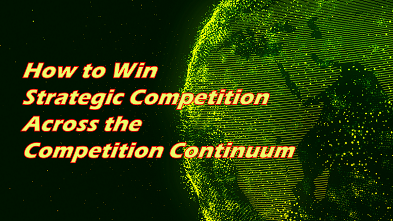[Editor’s Note: Several years ago, the Mad Scientist Laboratory featured Ian Sullivan‘s insightful post addressing how China and Russia were striving to achieve Decision Dominance by maintaining Information Advantage. In today’s post, we revisit the information environment with a joint submission by Brig Gen Thomas A. Drohan, Ph.D. (USAF-Ret.), and SGM Sohail Shaikh (USA-Ret.) and COL Randall P. Munch (USA-Ret.) from the TRADOC G-2’s Network Engagement Team, presenting a methodology for improving national security via whole-of-government integration. Their proposed cognitive maneuver, compelling narrative, and combined effect influence may be employed to integrate informational and physical power, enabling us to better understand and exploit our adversaries’ vulnerabilities across the competition continuum — Read on!]
Six years ago, Vice Chairman of the U.S. Joint Chiefs of Staff General Paul J. Selva acknowledged that the prevailing paradigm of “clearly defined states of peace and war” was no longer relevant. Today, the Joint Force remains focused on deterring armed conflict while our adversaries compete and wage effective warfare across the competition continuum (see Figure 1, below). Success in strategic competition requires an integrated and holistic approach, and the Department of Defense (DoD) is critical in enabling better alignment of military and non-military activities.
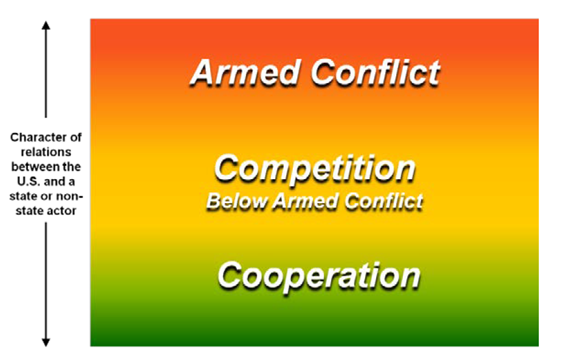
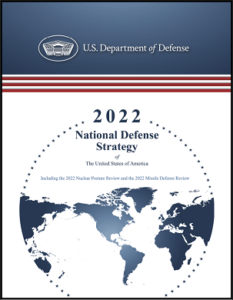 The 2018 Joint Concept for Integrated Campaigning (JCIC) fully supports “integrated deterrence,” described in the 2022 National Defense Strategy (NDS) as “using every tool at the Department’s disposal, in close collaboration with our counterparts across the U.S. Government and Allies and partners, to ensure that potential foes understand the folly of aggression.” The Joint Concept and NDS agree on the need for whole-of-government, integrated campaigning across the competition continuum to achieve U.S. national security.
The 2018 Joint Concept for Integrated Campaigning (JCIC) fully supports “integrated deterrence,” described in the 2022 National Defense Strategy (NDS) as “using every tool at the Department’s disposal, in close collaboration with our counterparts across the U.S. Government and Allies and partners, to ensure that potential foes understand the folly of aggression.” The Joint Concept and NDS agree on the need for whole-of-government, integrated campaigning across the competition continuum to achieve U.S. national security.
 This paper explains how the DoD can succeed in strategic competition by implementing guidance from the 2022 National Security Strategy, the 2022 NDS, the 2018 JCIC, and related guidance and doctrine. We will not describe every aspect of how the United States can compete to win. Instead, we offer a new approach for the DoD to improve national security by enabling whole-of-government integration. For context, we trace the progression of thinking about effective operations that led to the 2023 DoD Strategy for Operations in the Information Environment (SOIE).
This paper explains how the DoD can succeed in strategic competition by implementing guidance from the 2022 National Security Strategy, the 2022 NDS, the 2018 JCIC, and related guidance and doctrine. We will not describe every aspect of how the United States can compete to win. Instead, we offer a new approach for the DoD to improve national security by enabling whole-of-government integration. For context, we trace the progression of thinking about effective operations that led to the 2023 DoD Strategy for Operations in the Information Environment (SOIE).
Specifically, we introduce how cognitive maneuver, a compelling national narrative, and combined effect influence exploit critical vulnerabilities by integrating all elements of national power. The key to this approach is the DoD’s ability to coordinate the military element with other elements of national power. The linchpin is the DoD’s willingness to support whole-of-government efforts to combine informational and physical power for effective operations in the information environment.
The current SOIE describes “FUTURE” essential capabilities as the “Integration of Informational and Physical Power” during “planning initiation” (see Figure 2, below), where Informational Power is summarized as the ability to use information to achieve objectives and gain an information advantage to exert one’s will. The outset of planning must include coordinating military actions and objectives in the information environment — the aggregate of social, cultural, linguistic, psychological, technical, and physical factors that affect how humans and automated systems derive meaning from, act upon, and are impacted by information — with diplomatic, informational, and economic actions and objectives. Integrated planning must combine informational and physical power.
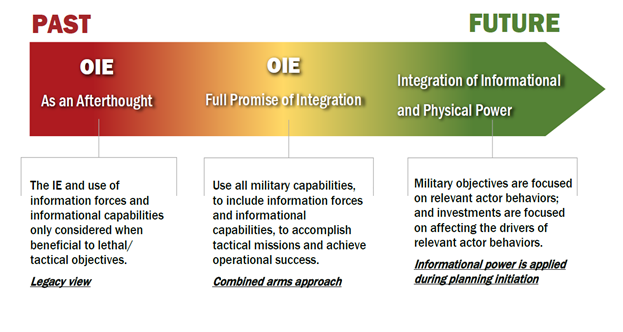
Cognitive maneuver is a four-step process (see Figure 3, below). The basic concept is to better understand the situation before and during planning while assessing progress and adjusting plans. It’s analogous to focusing on the “aim” portion of “ready, aim, fire.” At the strategic level, we first achieve an unprecedented understanding of ourselves, our adversaries, and our strategic environment. Then, we analyze our adversary to identify critical vulnerabilities we can exploit through focused engagement, assessment, and adjusting plans to achieve objectives.

Our core challenge is combining efforts across the DoD, U.S. Joint, Interagency, Intergovernmental and Multinational (JIIM) allies, and partners. Joint Force-led planning enables whole-of-government operations in the information environment. To succeed, the Joint Force must surpass military strategies’ limitations and adopt a more expansive mindset. The Joint Force must collaborate with instruments of national power to achieve a unified effort. Integrated campaigning is an essential enabler. The JCIC emphasizes, “Military power alone is insufficient to achieve sustainable political objectives, and there are limited means to achieve integration across the instruments of national power.”
Narrative strategy is vital to transforming perspectives and increasing unity of effort. The Joint Force must enable JIIM allies and partners to unify their efforts based on the national narrative. A national narrative shapes culture, encourages innovation, and motivates allies and partners to commit collectively to improve strategic effectiveness.
We must also understand our adversaries’ narratives to develop a compelling national narrative. We know that our adversaries seek acceptance from the global community. This tendency highlights why we must craft a national narrative. Adversaries’ perspectives, motivations, and objectives also provide insight into strategic competition’s changing character and enduring nature. Analyzing their narratives helps us identify vulnerabilities, anticipate their actions, and strategically impede their influence. This information advantage fosters adaptability within the Joint Force, essential in creating a compelling “United Strength” narrative that shapes the global narrative landscape.
United Strength emphasizes that success relies on our dedication to transformation, ensuring that every action, strategy, and operation is harmonious, magnifying our collective impact. This is how the strategic narrative enhances and compels our unity of effort. The responsibility for shaping and promoting this narrative of United Strength falls significantly on 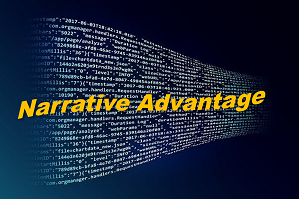 commanders and leadership at all levels. The narrative must be internally accepted and externally focused. Its effectiveness depends on building consensus and shaping global perceptions. Communicating this narrative through engagements, public diplomacy efforts, international media engagement, digital platforms, Joint exercises with allies, and military exchange programs is crucial. Consistent messaging and aligning our actions with our words, deeds, and images will reinforce the narrative’s impact.
commanders and leadership at all levels. The narrative must be internally accepted and externally focused. Its effectiveness depends on building consensus and shaping global perceptions. Communicating this narrative through engagements, public diplomacy efforts, international media engagement, digital platforms, Joint exercises with allies, and military exchange programs is crucial. Consistent messaging and aligning our actions with our words, deeds, and images will reinforce the narrative’s impact.
A compelling strategic narrative enhances the instruments of national power alongside the combined effect influence strategy. It enables us to target our adversaries’ vulnerabilities using a combination of effects that leverage all elements of national power. This integration is how we achieve success in strategic competition.
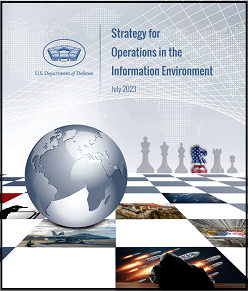 DoD strategy and Joint doctrine call for integrated “information forces” to lead operations in the information environment. However, Service functions, specialties, and plans concentrate on armed conflict. This focus is necessary but insufficient to win against adversaries that deter armed conflict while achieving objectives by other means.
DoD strategy and Joint doctrine call for integrated “information forces” to lead operations in the information environment. However, Service functions, specialties, and plans concentrate on armed conflict. This focus is necessary but insufficient to win against adversaries that deter armed conflict while achieving objectives by other means.
Information forces can fill this gap by operating across the competition continuum. Winning this competition requires a JIIM effort. Activities must be considered based on their impact across this continuum because opportunistic adversaries exploit any vulnerability to achieve a competitive advantage.
To win, Joint operations must shape favorable terms of cooperation and confrontation while remaining fully prepared to win armed conflict. This fight requires an in-depth knowledge of diverse threat networks and their strategies. Any instrument of power that helps target vulnerabilities and generate superior effects is relevant to the fight.
Three fundamental questions guide Ends, Ways, and Means (“strategy”) at any level:
(1) How causative and preventive?
(2) How psychological and physical?
(3) How cooperative and confrontational?
The answers help design superior strategies in cognitive maneuver and narrative with eight causative and preventive effects and 16 concepts of influence. Cooperative psychological effects are persuasion and dissuasion; cooperative physical effects are inducement and security. Confrontational psychological effects are deterrence and compellence; confrontational physical effects are defense and coercion. All these effects are combinable. Figures 5a and 5b (below) detail these combinable effects and their concepts of influence. The framework promotes combined effect JIIM operations beyond combined arms.

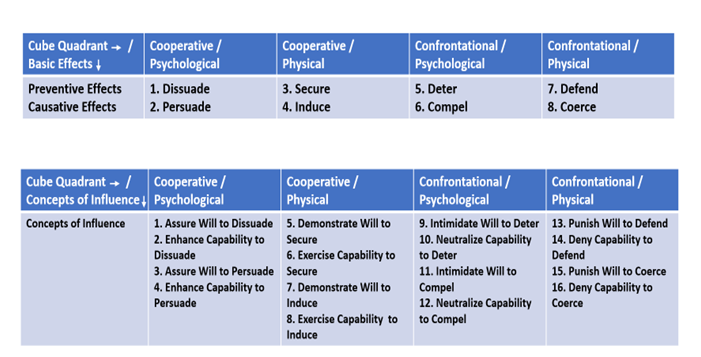
We’ve applied this methodology to China, our pacing challenge, and its combined effects on a U.S. defense of Taiwan are depicted in Figure 6 (see below): (a) defense that denies U.S. capability access to areas, (b) dissuasion of support for a U.S. defense by assuring a “United Front” will to influence Taiwan, (c) security with Russia by demonstrating the will to cooperate and exercising partnership capability, (d) compellence and deterrence by intimidating U.S. leaders’ will to be loyal and cognitively neutralizing U.S./allied capability to perceive the truth, and (e) coercion by punishing Taiwan’s will to resist. The People’s Liberation Army (PLA) actively learns and wages “cognitive warfare,” as Japan Ground Self-Defense Force Colonel Koichiro Takagi points out. Authoritarians already combine effects well beyond deterrence.
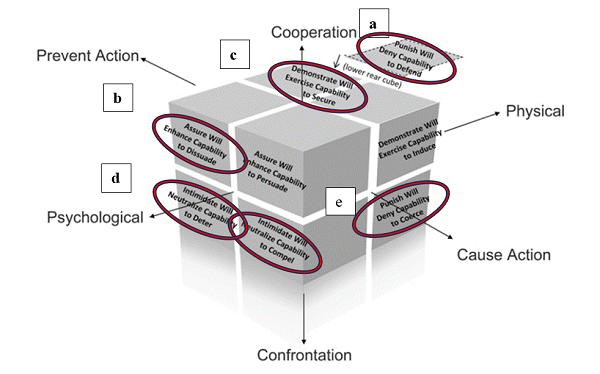
Figure 7 (see below) depicts the U.S. Indo-Pacific Command strategy: (a) security by demonstrating the will to cooperate, (b) inducement by exercising the capability to innovate and invest in asymmetric allied forces, (c) deterrence by denying adversaries a dominant air-sea capability, (d) coercion, and (e) defense by denying PLA capability to invade Taiwan when deterrence fails. Unlike China’s, this approach engages allies and partners, but only regards combat operations as “fighting to win.”
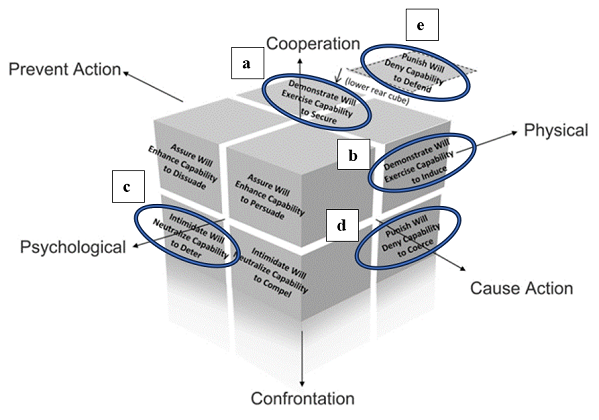
Information forces are essential to out-competing China’s combined effect influence. Plenty of examples show why.
China’s effects on the Philippines include physical coercion against fishing boats, psychological persuasion of officials, cooperative financial inducements, and confrontational compellence against residents. Our counterstrategy sails around and flies over China’s constructed territorial seizures.
The North Atlantic Treaty Organization (NATO) alliance faces similar combined effects from Russia. Putin’s national narrative portrays NATO as a fascist threat, amplifying historical distrust among some ethnic Russians. Ongoing Russian integrated campaigning blames the West for conflict in Gaza and Ukraine. Understanding such societal vulnerabilities is critical to competing for advantage.
In conclusion, the United States must implement integrated campaigning to sustain and win strategic competition. The DOD plays a vital role in deterring while defeating threats to national security, particularly as adversaries leverage artificial intelligence for novel effects. Cognitive maneuver methodology, a compelling narrative, and the combined effect influence framework integrate informational and physical power. These three enablers operationalize the DoD strategy for more effective and efficient operations across the competition continuum. Together, they help recognize and target our adversaries’ vulnerabilities. This proactive effort requires coordinating military and all instruments of national power to generate superior effects with lasting influence.
If you enjoyed this post, read the complete article here…
… then check out the following related Army Mad Scientist content:
China and Russia: Achieving Decision Dominance and Information Advantage, along with the comprehensive paper from which it was excerpted, and Three Dates, Three Windows, and All of DOTMLPF-P, by Ian Sullivan
Information Advantage Contribution to Operational Success, by CW4 Charles Davis
The Most Consequential Adversaries and associated podcast, with General Charles A. Flynn
Volatility in the Pacific: China, Resilience, and the Human Dimension and associated podcast, with General Robert Brown (USA-Ret.)
How China Fights and associated podcast
Flash-Mob Warfare: Whispers in the Digital Sandstorm (Parts 1 and 2), by Dr. Robert E. Smith
Two Vignettes: How Might Combat Operations be Different under the Information Joint Function? by proclaimed Mad Scientist Dr. Christopher Paul
Insights from Ukraine on the Operational Environment and the Changing Character of Warfare
Learning from LSCO: Applying Lessons to Irregular Conflict, by Ian Sullivan and Kate Kilgore
Weaponized Information: What We’ve Learned So Far…, Insights from the Mad Scientist Weaponized Information Series of Virtual Events, and all of this series’ associated content and videos [access via a non-DoD network], especially Disinformation and Narrative Warfare with Dr. Ajit Maan and Paul Cobaugh, Georgetown University’s Center for Strategic Studies
Sub-threshold Maneuver and the Flanking of U.S. National Security, by Dr. Russell Glenn
Global Entanglement and Multi-Reality Warfare and associated podcast, with COL Stefan Banach (USA-Ret.)
Hybrid Threats and Liminal Warfare and associated podcast, with Dr. David Kilcullen
The Exploitation of our Biases through Improved Technology, by Raechel Melling
What the Joint Force can learn from K-Pop “Stans” by Matthew Ader
LET’S TWEET, GRANDMA – Weaponizing the Social to Create Information Security, by CDR Sean M. Sullivan
Gaming Information Dominance, by Kate Kilgore
>>>>REMINDER: Army Mad Scientist wants to crowdsource the intellect of the Nation (i.e., you — our community of action!) through our Operational Environment Wicked Problems Writing Contest.
All entries must address the following topic:
How have innovations in asymmetric warfare impacted modern large scale and other combat operations, and what further evolutions could take place, both within the next 10 years and on towards mid-century?
We are accepting three types of submissions:
-
-
- 1500-word Non-Fiction Essay
-
-
-
- 1500-word Fictional Intelligence (FICINT) Story
-
-
-
- Hybrid 1500-word submission incorporating a short FICINT vignette, with a Non-Fiction Essay expounding on the threat capabilities described in the vignette
-
 Anyone can participate (Soldiers, Government Civilians, and all global citizens) — Multiple submissions are encouraged!
Anyone can participate (Soldiers, Government Civilians, and all global citizens) — Multiple submissions are encouraged!
All entries are due NLT 11:59 pm Eastern on May 16, 2024 at: madscitradoc@gmail.com
Click here for additional information on this contest — we look forward to your participation!
Disclaimer: The views expressed in this blog post do not necessarily reflect those of the U.S. Department of Defense, Department of the Army, Army Futures Command (AFC), or Training and Doctrine Command (TRADOC).

